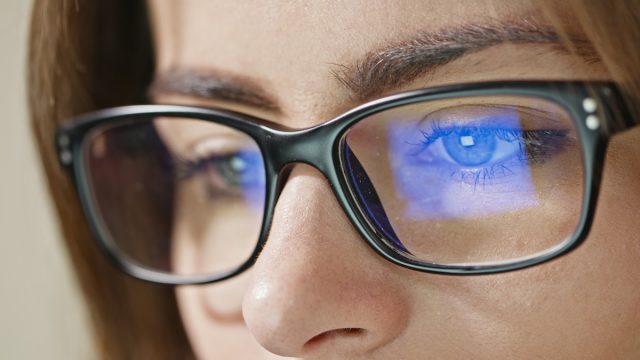How Your Eye Color Affects Your Reading Ability, New Study Finds

While brown is considered the most common eye color among humans, did you know that one in four people in the U.S. have blue eyes? Or that only nine percent of Americans are born with green eyes, according to the Cleveland Clinic? Learning about your eye color can teach you a lot about your vision and ocular health. According to a new study in bioRxiv—a website that publishes preprint studies that haven’t yet been peer-reviewed—your aptness of reading can be impacted by the amount of melanin in your eyes.
RELATED: 94% of People With These Vision Problems Develop Alzheimer’s, New Study Finds.
Interestingly, all human eyes are brown despite the hazel, green, or blue color they appear. In an interview with CNN, Gary Heiting, OD, a licensed optometrist and senior editor of the eye care website All About Vision, explained that one’s eye color is determined by the amount of melanin—which appears brown by nature—in their iris.
Out of all the possible eye colors, blue eyes have the least melanin in their irises because blue reflects, or scatters, more light out than it absorbs. Conversely, brown eyes have the most melanin in their irises, so they absorb more light, which makes them appear darker.
“It’s an interaction between the amount of melanin and the architecture of the iris itself,” said Dr. Heiting. “It’s a very complex architecture.”
And it’s an architecture that could affect your vision, too.
In a preliminary experiment, Kyoko Yamaguchi, a professor of biological and environmental sciences at Liverpool John Moores University, and her student, Faith Erin Cain, set out to determine whether there is a direct correlation between the color of someone’s irises and their ability to read in certain lighting conditions.
The study featured 39 adults of European ancestry—25 of whom have blue eyes and 14 of whom are brown-eyed—and included a mix of glasses and contact lens wearers. Participants completed a basic 30-second eye test during which they were exposed to increased levels of luminance and tasked to read codes depicted on a wall in varying degrees of low light.
RELATED: The 5 Best Sunglasses for Your Eyes, Doctors Say.
While those with blue eyes may experience a higher sensitivity to sunlight and bright artificial light—such as from a computer screen or fluorescent lighting—it turns out that they have a slight upper hand in dimly lit situations.
Yamaguchi and Cain found that those with blue eyes could adequately read the code test under darker conditions compared to those with brown eyes, who struggled to read below a minimum of 0.82 lux (“the amount of illumination provided when one lumen is evenly distributed over an area of one square [meter],” according to Britannica). For reference, blue-eyed participants were averaging a minimum of 0.7 lux.
“Through comparison with other studies comparing blue and brown irises, increased visibility in low light conditions could be the product of increased straylight in blue irises which casts a veil of light over the retina,” according to the study, which has not yet been peer-reviewed.
Yamaguchi and Cain noted that there is still more research to be done to fully understand the “association between melanin content and low-light visual acuity.”